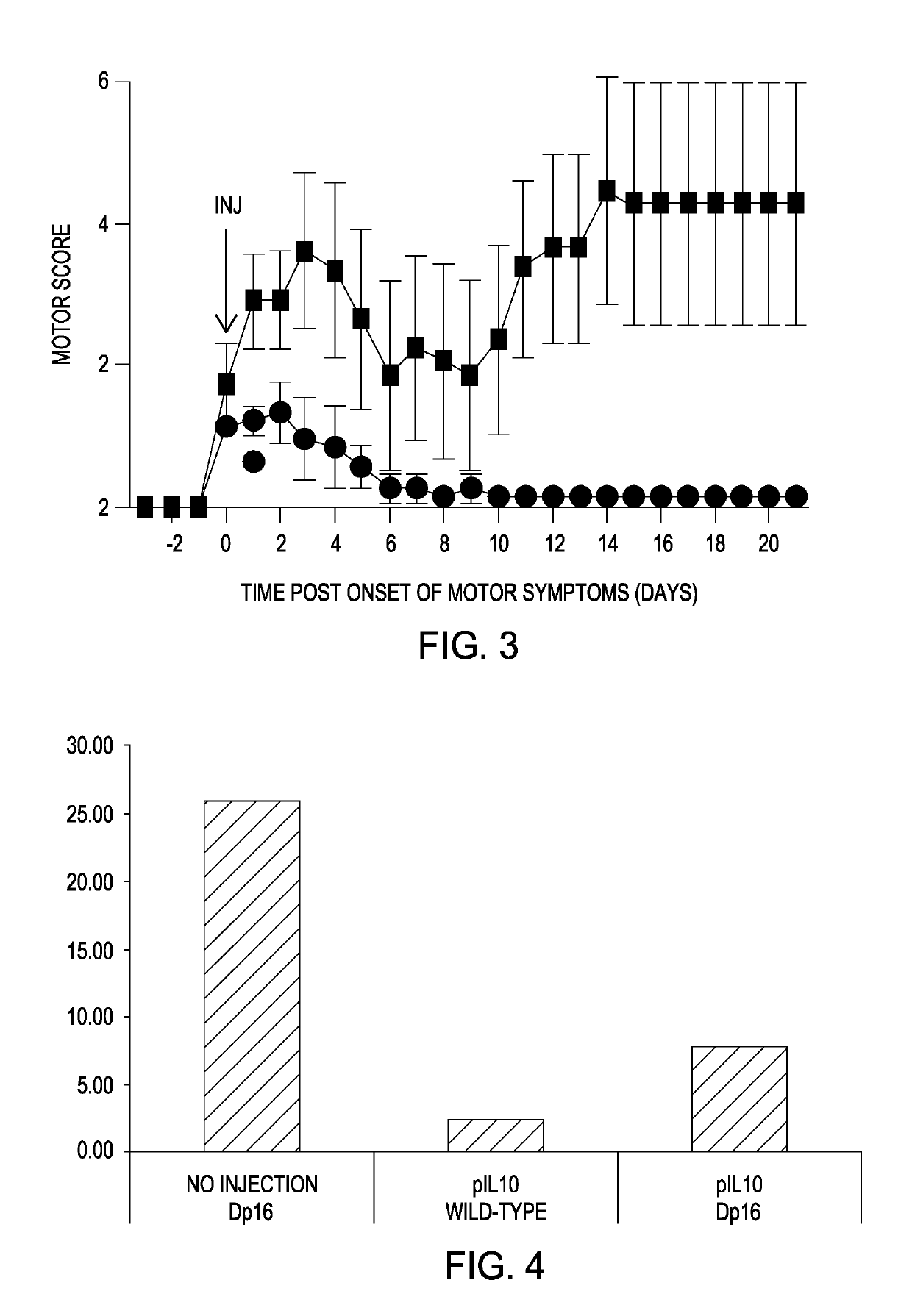Methods and compositions to enhance the Anti-inflammatory effects of interleukin 10
a technology of interleukin 10 and anti-inflammatory effect, which is applied in the direction of drug compositions, peptide/protein ingredients, dsdna viruses, etc., can solve the problem of down-regulation of il-10
- Summary
- Abstract
- Description
- Claims
- Application Information
AI Technical Summary
Benefits of technology
Problems solved by technology
Method used
Image
Examples
example 1
n Vectors
[0087]XT-250 is an expression plasmid that contains the rat IL-10 cDNA, used in these studies simply because rIL-10 engages with the rat IL-10R1 receptor considerably better than human IL-10 (hIL-10). XT-250, like its hIL-10 counterpart—XT-150—is a solution of DNA in D-mannose. Regardless of species, all of the IL-10 cDNAs used contain a point mutation yielding an amino acid change, F129S, that has been found to yield significantly longer duration of efficacy in pain models (Milligan et al., Pain, 126(1-3):294-308 (2006)). The plasmid backbone contains a Kanamycin resistance gene, CMV promoter, β-globin intron, growth hormone polyA and 2 AAV2 ITRs. This plasmid was also used to make AAV9 vectors.
[0088]LV02 is an expression plasmid that contains the above control elements with a cDNA downstream of the CMV promoter comprised of the hIL-10R1 coding sequence followed by a 2a, self-cleaving peptide, and the hIL-10 coding sequence. Test transfection of HT-1080 cells revealed surf...
example 2
g Data
[0089]It should be noted that IL-10 displays some idiosyncrasies in terms of species-specificity. For example, mouse IL-10 does not interact with the human IL-10 receptor, although human IL-10 does bind to the mouse IL-10 receptor, and human IL-10 binds weakly with the rat IL-10 receptor. For this reason, rat IL-10 (rIL-10) has generally been used in rat experiments, and human IL-10 (hIL-10) has been used in mouse, dog and horse studies. The fact that hIL-10 activates the rat IL-10 receptor only at high concentrations is a very useful feature, because co-expression of human IL-10R1 in target rat tissues results in full response to human IL-10. In order to simplify delivery, adeno-associated viruses (AAV) encoding rIL-10, hIL-10, or hIL-10R1 were constructed. Serotype 9 was chosen because AAV9 distributes very well when injected intrathecally and transduces a wide variety of cells including antigen-presenting cells such as astrocytes that themselves express IL-10R1. As shown in...
example 3
with the IL-10 / IL-10R1 Expression Vector to Assess Motor Disability
[0092]Rats treated with MOG to induce a mild relapsing-remitting MS-like pathology are injected intrathecally with doses of IL-10 plasmid previously shown to be efficacious in this model (Sloane et al. 2009) at a time when symptoms such as tail paralysis are visible. In addition to IL-10 plasmid, separate cohorts of rats are dosed with equal amounts of almost identical plasmid in which the IL-10 cDNA is replaced with the IL-10 / IL-10R1 cassette named LV02. The goal of this 30-day experiment is to establish whether LV02 works better than XT-250 (IL-10 expression only) at higher doses. At low plasmid doses (3 μg), little difference is expected between the two formulations. However, at high doses (˜100 μg), where loss of XT-250 efficacy is seen, continued efficacy of LV02 is expected.
[0093]Adult male Dark Agouti rats (250-300 g; Envigo), can be used to induce EAE via intradermal injection of 35 μg MOG in 0.01 M Na-Acetat...
PUM
 Login to View More
Login to View More Abstract
Description
Claims
Application Information
 Login to View More
Login to View More - R&D
- Intellectual Property
- Life Sciences
- Materials
- Tech Scout
- Unparalleled Data Quality
- Higher Quality Content
- 60% Fewer Hallucinations
Browse by: Latest US Patents, China's latest patents, Technical Efficacy Thesaurus, Application Domain, Technology Topic, Popular Technical Reports.
© 2025 PatSnap. All rights reserved.Legal|Privacy policy|Modern Slavery Act Transparency Statement|Sitemap|About US| Contact US: help@patsnap.com


